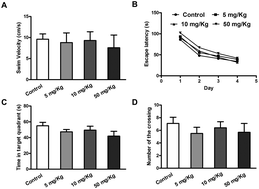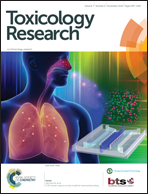Neurotoxicity, behavioral changes and gene-expression profile of mice exposed to SnS2 nanoflowers
Abstract
Recently, interest in the potential applications of tin disulphide nanoflowers (SnS2 NFs) in the treatment of waste water and their antibacterial properties has increased. However, their effects on neurotoxicity, brain cognition and behavioural injury, as well as the underlying mechanisms of these effects have remained unknown. In the present study, we compared the neurotoxicity of SnS2 NFs (50 nm) administered intragastrically at different doses (5, 10, and 50 mg kg−1) in mice for 60 days. The results showed that the neurotoxicity of SnS2 NFs in mice is dose-dependent. Furthermore, expression levels of genes related to oxidative stress, metabolism and signal transduction were also modified in the brain tissues of mice exposed to SnS2 NFs, supporting the SnS2 NF-dependent neurotoxic phenotype. Additionally, SnS2 NF exposure resulted in an abnormal ultrastructure in the hippocampus of the treated mice. Nevertheless, their body weight, organ coefficient and behaviour assessed in an open-field test and learning and memory test results assessed using a Morris water maze test remained unaffected. This suggested that the increased risk of neurotoxicity in SnS2 NF-treated mice was dependent on the dosage of SnS2 NFs. The relative level of safety was <5 mg kg−1 for 50 nm SnS2 NFs. The present study provides an experimental basis for the safe application of SnS2 NFs; however, chronic behavioural effects of SnS2 NFs remain unknown.



 Please wait while we load your content...
Please wait while we load your content...